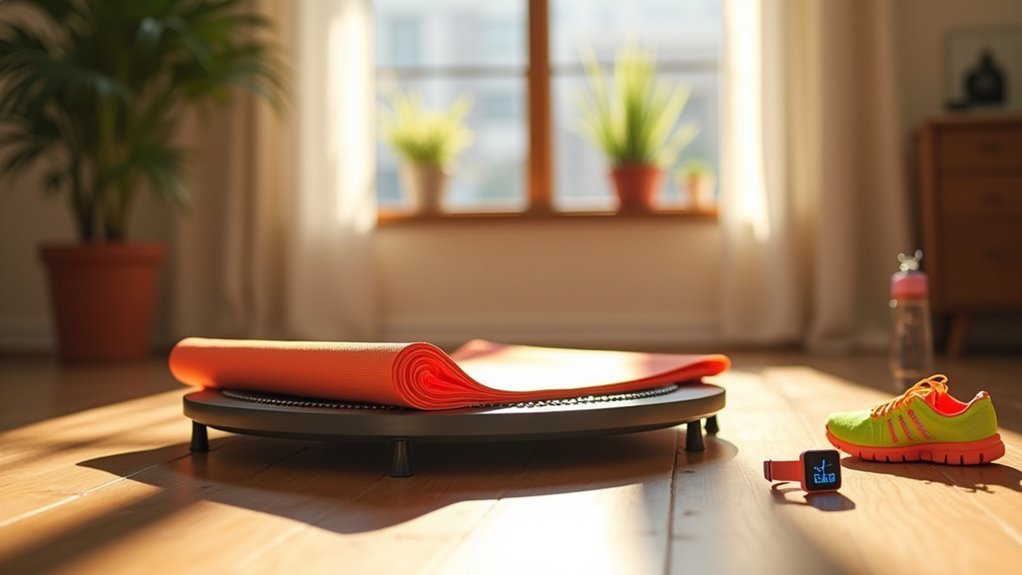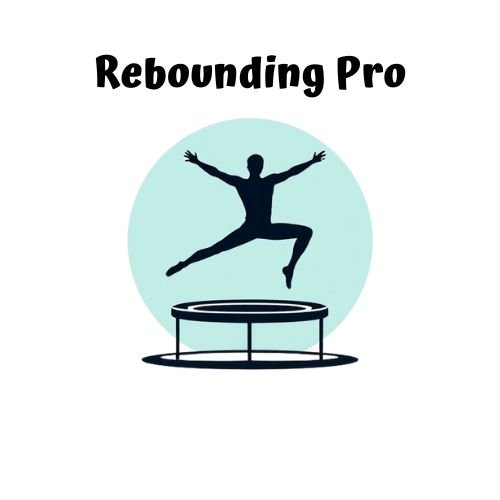Mini trampoline workouts can torch 6.9-12.4 calories per minute, with high-intensity sessions burning up to 720 calories per hour. You’ll maximize results by incorporating HIIT intervals of 30-60 seconds with brief recovery periods. Add resistance bands or weighted gloves to engage more muscle groups and boost calorie burn. Monitor your heart rate, aiming for zones 2-3 for fat burning with occasional bursts in zones 4-5. Discover how this low-impact exercise delivers impressive metabolic benefits while protecting your joints.
The Science Behind Mini Trampoline Calorie Burn

When you step onto a mini trampoline, your body activates multiple muscle groups simultaneously, creating an efficient calorie-burning environment.
The full-body engagement of mini trampoline exercise creates a perfect storm for efficient calorie burning.
Unlike running, this low-impact exercise reduces joint stress while still delivering impressive cardiovascular benefits.
Your body’s metabolic rate increases during rebounding and stays elevated afterward, meaning you’ll continue burning calories post-workout.
What’s particularly impressive is how trampolining adapts to your needs – your weight, intensity level, and workout duration all influence how many calories you’ll burn.
The beauty of mini trampoline workouts lies in their efficiency: twenty minutes of bouncing can burn as many calories as running at 6 mph for the same time. NASA research has shown that rebounding can be up to 68% more effective than jogging at similar speeds.
Plus, you’ll likely enjoy trampolining more than traditional cardio, encouraging longer, more consistent sessions without feeling the same level of exertion.
How Many Calories Can You Really Burn Rebounding?
Many fitness enthusiasts wonder about the exact caloric impact of their mini trampoline workouts, and the numbers might surprise you. On average, you’ll burn between 6.9-12.4 calories per minute rebounding, which translates to 250-325 calories per hour during recreational use—comparable to running at 6 mph. Rebounding calories can be precisely calculated using the MET value 3.5 for mini trampoline exercises.
| Duration | Low Intensity | High Intensity |
|---|---|---|
| 15 min | 100 calories | 180 calories |
| 30 min | 200 calories | 360 calories |
| 60 min | 400 calories | 720 calories |
Your personal burn rate varies based on weight, age, and fitness level. Heavier individuals typically burn more, while your body composition and age affect metabolic efficiency. For maximum calorie burn, try incorporating HIIT intervals and dynamic movements like jumping jacks to keep your workouts challenging.
Maximize Your Rebounder Workout for Fat Loss

To maximize fat loss on your rebounder, incorporate high-intensity intervals that alternate between all-out effort (30-60 seconds) and brief recovery periods.
You’ll boost your calorie burn by adding resistance elements like weighted gloves during basic bounces and jumping jacks. Studies show that rebounding burns approximately 9.4 calories per minute, comparable to running at six mph.
For best results, progressively increase your workout intensity each week while maintaining proper form and foot placement to prevent injury.
Intensity Interval Techniques
Maximizing fat loss on your mini trampoline requires strategic intensity manipulation, not just random bouncing. Incorporate Tabata-style intervals with 20 seconds of maximum effort followed by 10 seconds of rest, repeating for 4-8 rounds per exercise.
Alternate between squat jumps, high knees, and tuck jumps to engage different muscle groups. For beginners, start with 15/15 intervals while maintaining true sprint intensity. As you progress, add arm movements or increase pace.
Try pyramid intervals by gradually extending work periods from 30 to 60 seconds, or combine plyometric jumps with isometric holds. Adding wrist weights during your workout provides additional resistance to increase calorie burn and muscle engagement. Aim for an RPE of 8-9/10 during work intervals while maintaining proper form—knees slightly bent to protect joints.
Schedule 2-3 weekly sessions with 48 hours between workouts to prevent overtraining while triggering the afterburn effect.
Add Resistance Elements
While bouncing on your mini trampoline provides an excellent cardio workout alone, adding resistance elements can dramatically increase calorie burn and muscle engagement for faster fat loss results.
Resistance bands transform your rebounder session into a thorough workout that targets multiple muscle groups simultaneously while maintaining low impact on your joints.
Position bands around your shoulder blades for arm exercises or adjust them for targeted leg work. You’ll strengthen your core naturally as you maintain balance during each movement, creating a full-body workout experience. During resistance exercises, maintain proper stance with heels slightly wider than hips and a slight bend in the knees for optimal stability and effectiveness.
- Alternate between cardio bouncing and resistance moves for effective interval training
- Start with basic trampoline techniques before adding resistance bands
- Adjust band resistance to match your fitness level
- Focus on proper form to prevent injuries and maximize results
- Incorporate exercises that improve posture while strengthening key muscle groups
Mini Trampoline vs. Traditional Cardio: Calorie Comparison
When comparing mini trampoline workouts to traditional cardio exercises like running, calorie burn rates often surprise fitness enthusiasts. A moderate rebounding session burns 250-400 calories per hour, comparable to brisk walking or jogging. At 155 pounds, you’ll torch about 260 calories during a 30-minute bounce.
While running typically offers higher per-minute calorie burn at similar intensities, high-intensity rebounding with complex moves can actually exceed walking or running. Some controlled studies show participants burning up to 876 calories in a single trampoline session. Rebounding also supports circulation by stimulating the lymphatic system through the constant up and down motion.
The real advantage? You’ll likely stick with rebounding longer due to reduced joint stress and greater workout variety.
Unlike running’s repetitive impact on pavement, your trampoline absorbs shock, allowing consistent training without risking knee or ankle strain.
Intensity Matters: Heart Rate Zones for Optimal Results

You’ll achieve markedly better results on your mini trampoline by monitoring your heart rate zones during workouts.
By understanding which zone you’re training in—from recovery-focused Zone 1 (50-60% max HR) to high-intensity Zone 5 (90-100%)—you can tailor your bouncing routines to match your specific fitness goals.
To maximize your aerobic training efficiency, aim to spend most of your trampoline sessions in Zones 2-3 for fat burning and endurance, while strategically incorporating short bursts in Zones 4-5 for power and anaerobic development. For optimal health benefits, ensure your trampoline workouts accumulate at least 150 minutes weekly of moderate-intensity bouncing or 75 minutes of vigorous bouncing.
Target Heart Rate Zones
Understanding your target heart rate zones transforms ordinary mini trampoline workouts into precision fitness tools. Your maximum heart rate is calculated as 220 minus your age, with each zone offering distinct benefits.
By monitoring where you’re working, you’ll maximize results and avoid overtraining. The Karvonen formula provides a more personalized calculation by incorporating your resting heart rate.
- Zone 1 (50-60%) – Perfect for warm-ups and recovery periods on your mini trampoline
- Zone 2 (61-70%) – The fat-burning sweet spot where you’ll build cardiovascular health
- Zone 3 (71-83%) – Enhances aerobic endurance but requires balance to prevent fatigue
- Zone 4 (84-91%) – Short bursts at this intensity improve speed and carb utilization
- Zone 5 (90-100%) – Brief maximum efforts that boost anaerobic fitness
Vary your trampoline session across these zones for thorough fitness gains, prioritizing Zones 1-2 for most of your workout time.
Maximize Aerobic Training
To maximize aerobic benefits on your mini trampoline, intensity becomes the essential factor that determines your results. By incorporating high-intensity interval training (HIIT) on your rebounder, you’ll greatly increase oxygen uptake and aerobic endurance.
Aim for 15-60 minute sessions where you alternate between periods of vigorous bouncing and recovery phases. This approach enhances metabolic health and cardiovascular efficiency while improving your exercise capacity. You’ll experience greater physiological adaptations than with steady-state bouncing alone.
Remember to customize intensity to your fitness level by monitoring your heart rate during workouts. As your heart grows stronger, it’ll pump blood more efficiently, enhancing circulation and reducing disease risk. This process leads to a reduced heart rate during rest periods as your cardiovascular system becomes more efficient.
For maximum results, combine your trampoline routine with resistance exercises and vary your rebounding movements to keep workouts effective and engaging.
30-Minute Metabolism-Boosting Rebounder Routines
While traditional workouts often require lengthy sessions for meaningful results, mini trampoline routines can supercharge your metabolism in just minutes. HIIT sessions on your rebounder alternate 30-60 second high-intensity bursts with brief rest periods, burning up to 240 calories in just 25 minutes while triggering prolonged EPOC effects.
- Combine knee-high sprints with arm circles to engage multiple muscle groups simultaneously.
- Incorporate twisting jumps to activate your transverse abdominis while maintaining cardio intensity.
- Try 2-3 inch gentle bounces to sustain fat-burning heart rates (120-150 BPM) with minimal impact.
- Add medicine ball passes during jumps for increased core resistance training.
- Alternate directional changes (forward/backward hops) to prevent metabolic adaptation.
You’ll protect your joints while achieving intense cardiovascular benefits that continue burning calories long after you’ve finished your workout. Following the 25-move structure with 50 seconds on and 10 seconds rest creates an efficient workout format that maximizes calorie burn while preventing burnout.
Track Your Progress: Measuring Fitness Gains on a Mini Trampoline
How can you truly know if those energetic bounces are transforming your fitness level? Monitor your heart rate during workouts to gauge intensity and cardiovascular improvements. Your wearable device, like a Fitbit, can track your rebounding sessions by setting up custom exercise entries that capture heart rate data and estimate calories burned.
Integrate your routine with fitness apps that offer structured workouts and progress tracking. These tools can help you analyze movement patterns, measure endurance improvements through longer workout durations, and customize exercises based on your specific goals.
Consistency is essential for seeing real results. Set regular rebounding sessions and use your tracking data to adjust intensity as needed. Aim to complete two daily sessions of 10 minutes each to achieve optimal fitness benefits.
The numbers don’t lie—watch your stamina increase and recovery time decrease as your fitness improves.
Customizing Your Rebounding Workout for Your Fitness Level
Regardless of your current fitness level, mini trampoline workouts can be perfectly tailored to meet your specific needs and goals.
Your rebounding journey begins with selecting the right equipment—choosing between 39″ compact frames for beginners or 44″ options for more dynamic movements if you’re advanced.
Customize your experience further by adjusting bounce firmness: softer for joint-friendly intense sessions or firmer for quick-paced workouts. The adjustable EnduroLast elastic cords provide a customizable bounce that adapts to your preferred intensity level.
Progress naturally through exercise complexity:
- Start with simple side steps to build coordination if you’re new
- Incorporate reaches and twists to enhance core strength as you improve
- Add scissors and knee lifts when you’re ready for cardiovascular challenges
- Adjust workout intensity using video playlists for guided progression
- Mix cardio and strength elements to create balanced routines for your level
Frequently Asked Questions
Is Rebounding Safe During Pregnancy or With Joint Problems?
Consult your healthcare provider before rebounding during pregnancy due to fall risks and limited studies. If you have joint problems, you’ll need to exercise caution, use proper form, and consider modified movements to reduce stress on joints.
How Long Does It Take to See Weight Loss Results?
You’ll typically notice initial weight loss within 1-3 weeks. Expect to lose 1-2 pounds weekly with consistent effort. Significant results become visible after 4-6 weeks if you maintain your calorie deficit and exercise routine.
Can Mini Trampolines Support Users Over 250 Pounds?
Yes, many mini trampolines can support users over 250 pounds. Look for models with heavy-duty steel frames, arched legs, and weight capacities between 300-550+ pounds. Always verify the manufacturer’s stated weight limit before purchasing.
Are There Age Restrictions for Mini Trampoline Workouts?
No, there aren’t strict age restrictions for mini trampoline workouts. Your health condition matters more than age. Children under six need supervision, while seniors can enjoy low-impact benefits with proper medical clearance if needed.
How Does Rebounding Affect Lymphatic System and Cellular Health?
Rebounding stimulates your lymphatic system through up-and-down movements, increasing lymph flow up to 15 times. It also enhances cellular health by boosting white blood cell production and improving oxygen delivery to your tissues.
In Summary
You’ll find that mini trampoline workouts offer an efficient, low-impact way to torch calories while having fun. By maintaining proper intensity, tracking your progress, and customizing routines to your fitness level, you’re setting yourself up for success. Whether you’re a beginner or fitness enthusiast, rebounding delivers impressive calorie-burning results in less time than traditional cardio. Start bouncing today and watch your metabolism soar!





Leave a Reply